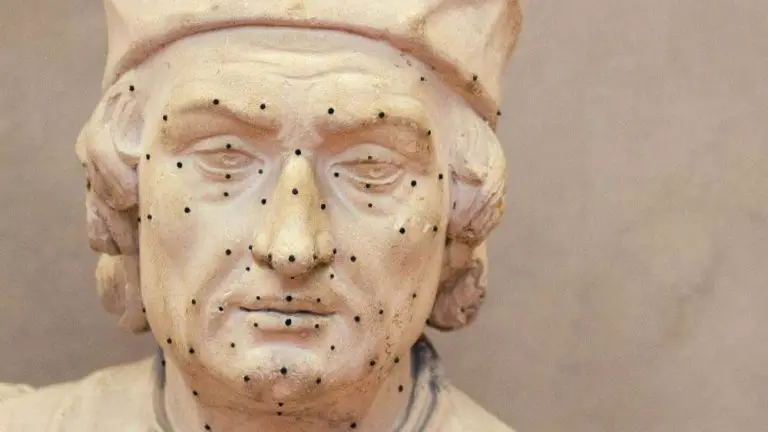Sculpture vs. Statue: What’s the REAL Difference?
We often use the words “sculpture” and “statue” interchangeably to mean three-dimensional artworks. But are sculptures and statues the same thing? For example, is the Statue of Liberty a statue or a sculpture? What about Michelangelo’s David?
Sculpture is a visual art that creates three-dimensional artwork through reductive methods, such as carving, or additive techniques, like molding, casting, and assembly. A sculpture is considered a statue if the subject is a person, animal, or diety, and the work is created life-size or larger.
While all statues are sculptures, not all sculptures are statues.
If you look at a 3D work of art, how do you know if it is a statue or a sculpture? Unfortunately, the difference between the two terms can be blurred, so it’s a little confusing.
Let’s find out what makes a 3-dimensional artwork: a statue, a sculpture, or both.
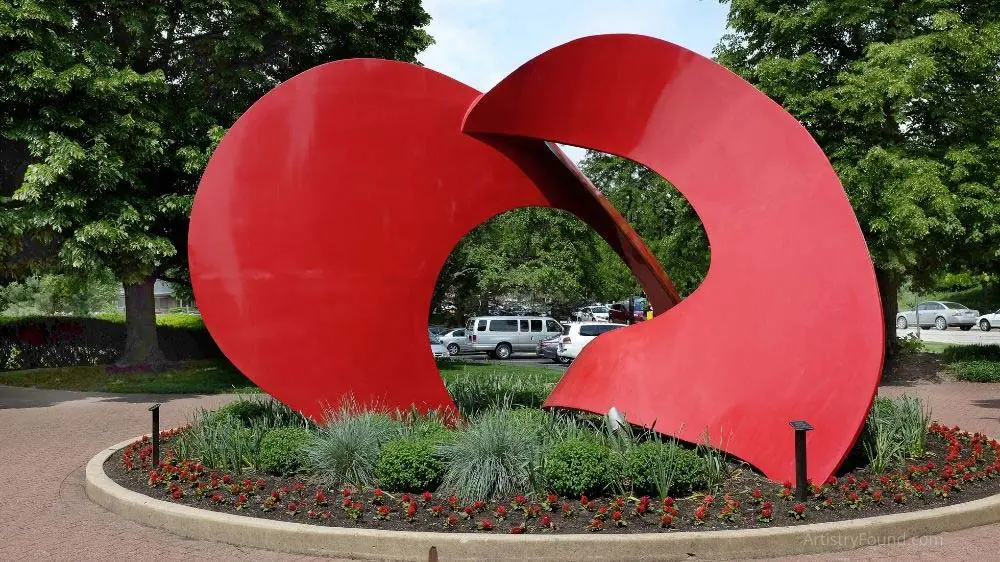
(This article may contain affiliate links and I may earn a commission if you make a purchase)
Differences Between a Sculpture and a Statue
Although an artwork can be both a sculpture and a statue, the two words are not synonymous. There are essential differences between sculpture and statue in definition, purpose, theme, materials, and size.
Definition
- Sculpture refers to the art of carving or modeling solid objects using clay, wood, stone, plaster, or other materials. A sculpture can be large or small. An example of a sculpture is “Landforms” (see image above) by Jack Arnold in Naperville, Illinois.
- A statue is a kind of sculpture where the subject matter is a person, animal or religious diety, and is life-sized or larger, like the Statue of Liberty. (While the Statue of Liberty is a ficticious person, she’s still a person and as such is considered a statue.)

Purpose of a Sculpture or Statue
- Sculptures are made as works of art. They are meant to be beautiful, interesting, and creative. They are referred to as “fine art”. For example, Anish Kapoor’s “The Bean” (image below) is a magnificent and thought-provoking piece of public art.
- Statues are made with a specific purpose, usually commemorating someone or honoring an animal, person, or deity. However, despite their original purpose, many statues have become works of art in themselves, such as Rodin’s “The Burghers of Calais.”
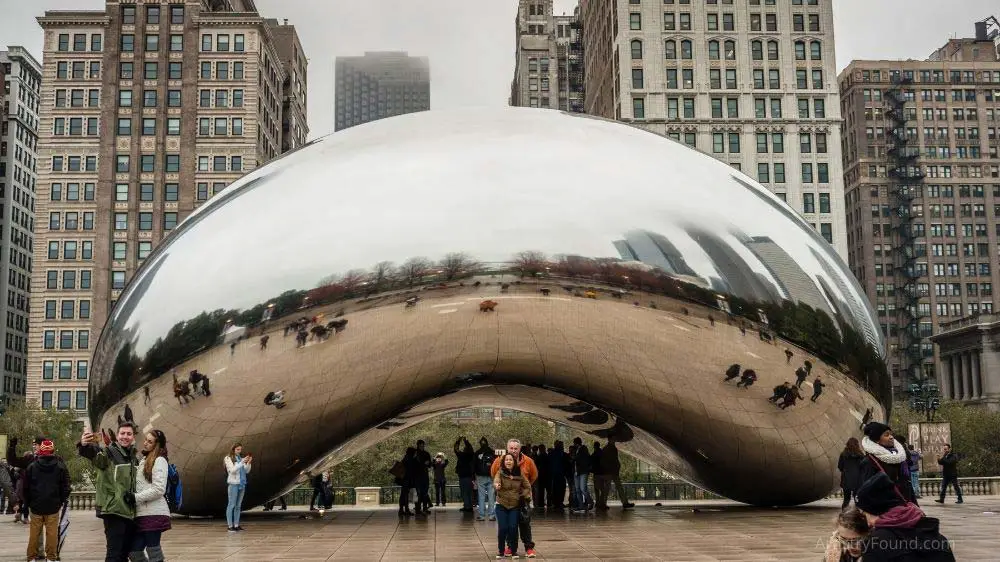
Theme of Sculptures and Statues
- Sculptures are created as works of art and so can have any theme or subject. For example, Andy Warhol created sculptures of everyday household products, like boxes of Kellog’s cornflakes.
- Statues are always figures of animals, people, or deities. One of the world’s most famous statues depicts Diana, Princess of Wales, in Kensington Gardens.
Materials Statues and Sculptures are Made From
- Sculptures can be made from any material whatsoever: old clothes, tires, plastic water bottles, even ice. The massive spider sculpture outside the Tate Modern in London is made of a combination of recycled materials.
- Statues are made from more traditional materials, such as wood, plaster, clay, stone, glass, wax, or resin. For example, the Marine Corps War Memorial (Iwo Jima) is made of concrete faced with granite.
Differences in Size: Sculptures and Statues
- Sculptures can be any size, ranging from tiny micro-sculptures to massive, towering shapes. You could keep a small wire sculpture on your dining room table, for instance. One of the most ancient sculptures, the Venus of Berekhat Ram, which dates back thousands of years, can fit in the palm of your hand. A gigantic modern sculpture is “The Angel of the North” in England.
- Statues are usually life-sized or larger. Smaller statues are called statuettes, while statues of the head and shoulders are called a bust. The Sphinx at Giza in Egypt is an example of a colossal statue.
A Closer Look at Sculptures
The word “sculpture” has more than one meaning.
On the one hand, sculpture refers to a branch of visual arts, known as the plastic arts, where artists create three-dimensional artworks.
The word “sculpture” is also a term used to refer to the end product of a specific three-dimensional artwork.
A sculpture can be a model of something, like a person or animal (which we call a statue) or a completely abstract three-dimensional shape.
How Sculptures Are Made
The word “sculpt” refers to the way an artist makes a sculpture. There are various methods of sculpting or creating a sculpture.
- Reductive method: This refers to creating a sculpture by taking away material, such as chiseling away stone, like sandstone or alabaster, or carving wood or bone. For example, the Venus de Milo was carved from marble by Alexandros in 150 BC, which is why it has survived for thousands of years. Cultures that carved using wood, such as Native Americans and many African cultures, created magnificent sculptures, many of which have not survived.
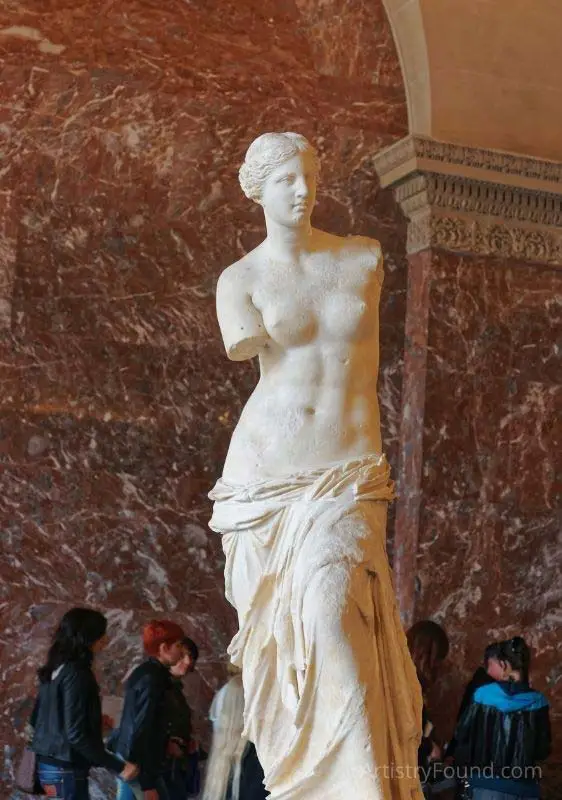
- Additive method: This means putting material together to create a sculpture, like forming an image from clay or welding together pieces of steel. Many ancient sculptures were modeled from terracotta clay and then baked to make them more durable. For example, the unusual, elongated figures from the Nok culture in Nigeria are made from clay and date back over one and a half millennia.
- Assembling: This additive method indicates that the sculptors used existing items or found objects to create the sculptures, putting them together to make something new. Modern sculptures made from recycled materials are sometimes called “assemblages”.
- Casting: This additive method means making a sculpture by melting down a metal like bronze or a substance like resin, pouring it into a mold, and letting it cool. The artist first makes the mold from clay or wax. Famous bronze cast sculptures (often just called “bronzes”) are the Benin bronzes, a collection of plaques and statues, which adorned the royal Benin palace, dating back to the thirteenth century.
Different Kinds of Sculptures
Although sculptures are, by definition, three-dimensional, not all sculptures are the same in form.
- Freestanding sculptures: These sculptures are self-supported, standing on their own, and three-dimensional. You can walk around or even sometimes through these sculptures.
- Relief sculptures: In relief sculpture, the sculpture projects from but remains attached to a flat background – it is therefore not wholly three-dimensional. Images on coins are an excellent example of relief sculpture. Bas-relief sculptures are only slightly raised from the surface, while more than half of the image stands out in high relief sculptures. Famous examples of this type of sculpture can be seen at Angkor Wat in Thailand, where stories from Hindu mythology are depicted on temple walls.
History of Sculpture
Sculpture is one of the most ancient arts, and many examples of sculpture from the past still exist because of the enduring materials used to make sculpture.
Prehistoric Sculpture
The art of sculpture dates back thousands of years, and many experts say that the Löwenmensch, made 40,000 years ago in Germany, is the first genuine sculpture. Made from ivory and standing about 12 inches tall (30 cm), the statue is of a human-lion hybrid. Scholars assume that the sculpture was made for religious or ritual purposes.
Other sculptures from prehistoric times seem to be related to fertility or sexuality. Many of them are female figures with exaggerated breasts and bellies, such as the Venus of Willendorf. This small limestone figure was possibly a totem or good luck charm as it can be held in your hand.
The Sculpture of Ancient Civilizations
Although ancient civilizations were all vastly different in time and culture, they all produced sculpture for the same purposes: first, sculpture was made for religious, ritual, or worship purposes. Some of the best-known sculptures in the world fall into this category.
For example, the Ancient Egyptian statues of cats are images of the deity Bastet, while there are many examples of Roman statues of the goddess Venus. Ancient Greek temples were filled with statues of gods and goddesses.
Their naturalistic and realistic figures influenced the art of sculpture for millennia – the statue of Zeus at Olympia, by Phidias, dates back to 400 BC.
Sculpted masks are a common ritual item from ancient civilizations, especially in Africa, and are made from many different materials. Totem poles are also a form of religious sculpture, common to several societies.

Egypt is also famous for its funerary art or tomb monuments to remember the dead – the tomb of Tutankhamen is a magnificent example. The function of funeral statuary was also to preserve the dead, for instance, in the form of sculptural canopic jars that held body parts.
Some cultures believed that statues buried with the dead would come alive in the afterlife and accompany them. The terracotta soldiers in Xian, China may have been created for this purpose.
However, sculptures also began being made as official or civic portraits to honor and commemorate influential people, usually rulers – the exquisite bust of Nefertiti is an example.
The sculpture portrait, a realistic statue of an individual, became very popular in ancient Rome. It was regarded as a great honor to have a sculpture of yourself erected in a public place.
Sculpture was used in this way to communicate power and authority. The seated sculptures known as the Colossi of Memnon are statues of Pharoah Amenhotep III and made to strike awe into the hearts of all who saw them.
The Stele of the Vultures from ancient Mesopotamia is a relief sculpture commemorating a victory in battle.
Sculpture in the Renaissance
Many art students regard the Renaissance, roughly 1300 to 1600 AD, as the height of artistic achievement in the western world. The word “Renaissance” means rebirth, as people of the time saw themselves as recreating the civilized world of the ancient Greeks and Romans.
During the Renaissance, with artists such as Michelangelo, Bernini, and Donatello, sculpture became more realistic, and the subjects of sculpture became broader. However, most sculpture was still commissioned for churches.
The sculpture at Trevi Fountain in Rome is a famous sculpture of this time, as is Donatello’s statue of David.
Sculpture was still seen as more than art – it was the wealthy and powerful (like the Pope or the de Medici family) who could afford to commission incredible sculptures from these artists.
It was during this time that sculpture gained an additional purpose: it became decorative, used to adorn homes, public places, and even cities.
Sculpture in the Nineteenth and Twentieth Century
Until the twentieth century, sculpture focused chiefly on representing the human form, with statues made of religious leaders and political, military, and civic heroes.
Just as in ancient times, sculpture was used to communicate values and beliefs. For example, the Statue of Liberty was created to communicate freedom and the ethos of the United States.
The statues of the Presidents at Mount Rushmore is another example of a sculpture created for political reasons.
A new development in art was born with the modern era: modernism, a desire for new artistic and cultural forms.
One of the most influential sculptors was Auguste Rodin, who moved sculpture from the formal statues erected all over Europe to more natural, softer forms – sculpture as beauty rather than for religious or political purposes. “The Thinker” is one of his most admired works.
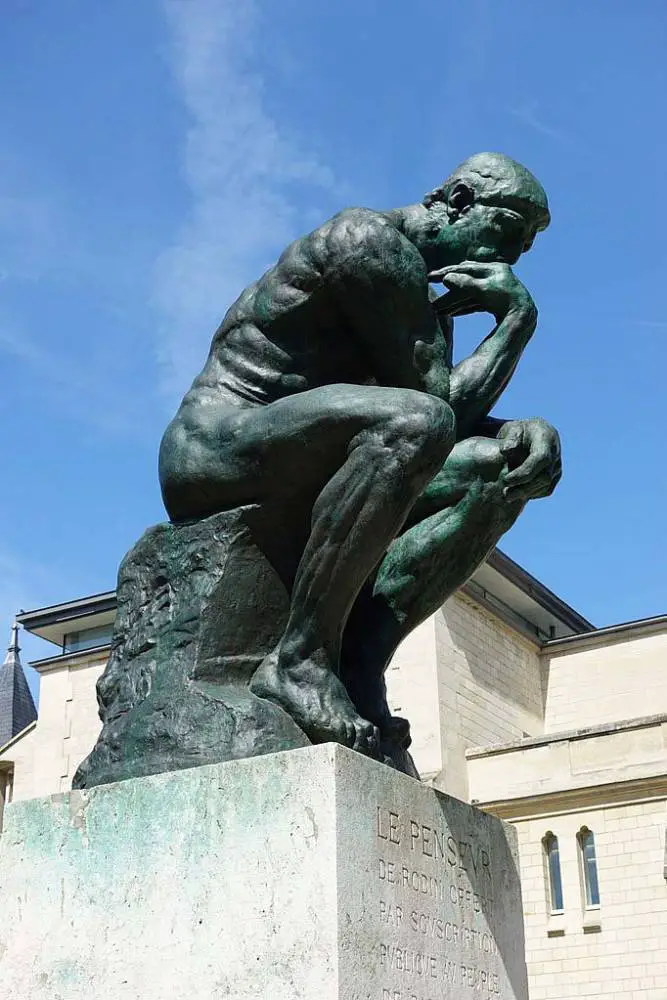
Other artistic movements of the twentieth century also influenced sculpture, especially abstract art, where sculpture was no longer representational or realistic, focused instead on shape and form, movement and stillness, light and dark.
Kandinsky’s mobiles are a fascinating form of modern sculpture, while Marcel Duchamp questioned what art is, displaying a urinal as a sculpture.
During this time, the difference between sculpture and statue became important – up until this time, most sculptures had been statues.
Contemporary Sculpture
Today, definitions of sculpture are blurred and continually changing. Traditional sculpture has been challenged by the art of contemporary installations, which use multiple objects to create three-dimensional art.
Tracy Enim’s “My Bed” (1999) exhibited her unmade bed and various items from her bedroom.
Other installations are site-specific and interactive, using water, light, and other materials to create three-dimensional art experiences. For example, Random International’s “Rain Room” is an installation in the Middle East that allows visitors to walk in the rain without getting wet.
A Closer Look at Statues
A statue is a kind of sculpture in the form of a three-dimensional representation of a figure. The figure could be an animal, a human, a mythological creature, or a deity. Statues are usually fairly realistic – meaning the subject of the statue is recognizable.
So, statues fall under the artistic category of sculpture. However, statues are different from other sculptures as they are not usually created simply as artworks to be appreciated for their beauty or creativity.
Instead, statues are typically designed for one of four reasons.
Religious Statues
Some of the most ancient statues in the world were created for religious reasons, usually to worship or honor a god or deity.
Most Christian churches contain statues of Jesus or Mary, with one of the most famous statues being Rio’s Christ the Redeemer.
Hindu temples are filled with statues of deities, while there are many representations of Lord Buddha as well. The Spring Temple Buddha in China is the tallest religious statue in the world, standing 420 feet (128m).

Statues Created For Civic or National Pride
Statues are often created as commemorations of famous or influential people, usually rulers or military leaders.
For this reason, they are often displayed in public places. These statues are life-sized or larger, with their imposing size adding to the symbolism of statesmanship, philanthropy, or other values and beliefs they transmit.
Famous examples of statues created for civic or national pride are the Statue of Liberty and the statue of Lincoln at the Lincoln Memorial.
Funerary Statues
Funerary statues are figures that are placed at tombs or in graveyards. In the past, statues known as effigies were placed on the tops of vaults, a sleeping figure forming the tomb’s lid.
Many examples exist from the Middle Ages, where knights were buried, and an effigy is placed on the grave. Graveyards also include statues of angels and other guardians.
Decorative Statues
Statues are often used to decorate our homes and gardens, from the comical garden gnome to reproductions of famous sculptures. Serious artists tend to scorn these statues and do not regard them as art or sculpture.
However, they give many people pleasure and beautify our surroundings.
Final Thoughts
The difference between sculpture and statue is blurred and overlapping.
On the one hand, sculpture refers to the broad artistic genre of making three-dimensional artwork. On the other hand, statues are a kind of sculpture in the form of a human or animal.
More Articles About Sculpture
- How To Price a Sculpture: An Eight-Step Guide
- Why Do Sculptures Have Nail Holes? (Explained!)
- Freestanding Sculpture (Definition & Famous Examples)
- What is Subtractive Sculpture? (Definition and Examples)
Sources:
https://en.wikipedia.org/wiki/Statue




